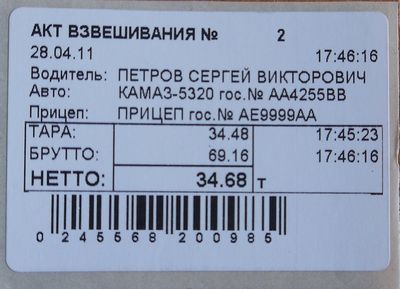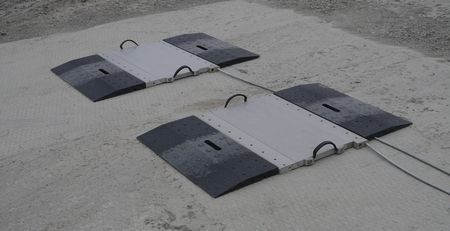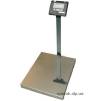Enterprise Weighing Control
Weight control at industrial and manufacturing enterprises is used to account for both weight and piece goods. As a rule, the accounting system begins with truck and railway scales. Control is exercised over the incoming flow of goods - raw materials, auxiliary materials, equipment, as well as the outgoing flow - finished goods, secondary raw materials and waste.
Full control of the weight of incoming and outgoing transport ensures accurate accounting of all material assets and prevents unauthorized import or export of “unaccounted” products. There are specific features when weighing different types of transport - for example, for tanks with bulk products, such as petroleum products, industrial gases and liquid chemicals.
Thus, “transport weight control” is the first and one of the key points of accounting at the enterprise. It is used to record the weight of automobile and railway transport, including tanks for transporting bulk products. A well-established system allows for effective monitoring of weighings and detection of deviations.
For example, when a vehicle leaves the enterprise premises, the estimated (theoretical) weight of the cargo is indicated in the consignment note and electronic documents. The actual weight is determined by weighing the vehicle with the cargo and subtracting its tare. If the obtained data is within the permissible deviations, the security issues permission to leave. Otherwise, a full inspection of the vehicle and its contents is initiated.
To automate weight control of automobile and rail transport, several systems are integrated: weighing equipment, enterprise accounting system, video surveillance and RFID identification.
By combining accounting and control components into a single information complex, the enterprise gets the opportunity not only to control products and document flow, but also to track personnel actions, minimizing the influence of the human factor.
All events are automatically recorded in the system and accompanied by a video and photo archive, which ensures accounting transparency and increases the security of logistics operations.
After the weight control points of road and rail transport, accounting continues at the warehouses of raw materials, auxiliary materials and finished products.
At the raw material warehouses, incoming quality and quantity control is implemented, followed by the placement of products in storage areas. As a rule, incoming raw materials and auxiliary materials are first placed in a temporary storage area (quarantine). After control weighing, recounting and quality assessment, the products are moved to permanent storage areas. Upon receipt of applications from production areas, the warehouse forms the required amount of raw materials and auxiliary materials for sending to production.
At the finished product warehouses, weight accounting is part of the acceptance process from production, carried out by the quality control department (QCD). Finished products are checked for quantity, confirmed by weight and accompanied by the issuance of quality certificates. By comparing data from all weight accounting points, the enterprise can form a weight balance — comparing the volumes of received raw materials and supplies with the volumes of manufactured and shipped finished products.
At the first stage of automation of weight accounting at the enterprise, we recommend the implementation of automated workstations (AWS) at key accounting points:
- Truck scale
- Railway scale
- Incoming goods warehouse
- Finished goods warehouse
After successful setup and debugging of automated accounting at these key points, you can proceed to expand the system to production areas. At this stage, an analysis is carried out, and first of all, the so-called “problem” zones are automated - areas with a high probability of errors or risks of significant losses.
In addition to stationary scales, it is advisable to use mobile portable scales at some enterprises. This makes it possible to conduct random inspections and check vehicles for excess axle loads.
Mobile weighing control points (MWC) can be used for both scheduled and unscheduled inspections of vehicles transporting products. For example, at agricultural enterprises - for random inspection of grain crops.
MWCs are recommended to be equipped with a video surveillance system with remote monitoring capabilities, which increases the transparency and reliability of weight control.
Results of vehicle axle weighing
Efficient weight control at an enterprise is not only a means of accounting, but also a key element in ensuring the transparency of logistics processes, preventing losses and eliminating the human factor. The implementation of automated weighing solutions at key points - from truck and railway scales to raw material and finished product warehouses - creates a solid foundation for a reliable material flow management system.
Do you want to put your accounting in order and reduce risks?
Contact us - Vostok specialists will select the optimal solution for automating weight control, taking into account the specifics of your enterprise.

















